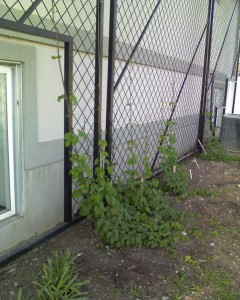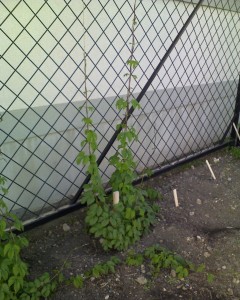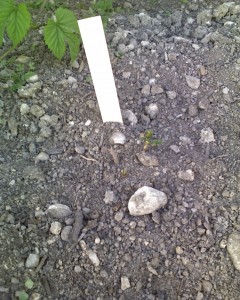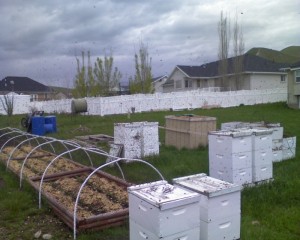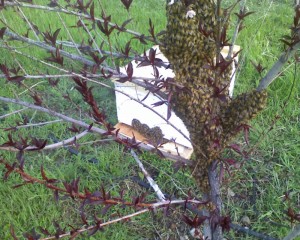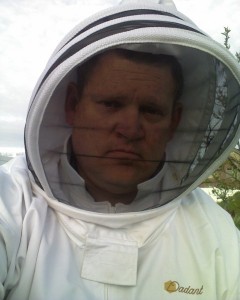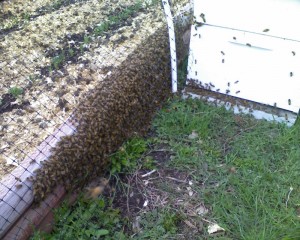| Checking in on the hops found the growth to be quite impressive. My chinook hops that I planted last year are looking quite healthy. I feel that we should be able to get enough growth off of them to make a pretty good shade block on the south of the house. I might even be able to get a few pounds of hops as well.
I have started the hops up some strings like most of the hop growing people suggest. I have not pruned the plants back to two or three shoots per plant like most suggest. I am not growing for hop production, but for shade. If I get hops that I can use in my brewing that is just a bonus. |
|
| The hops that I gathered out of the wild just south of Avon are starting to peek up. All five rhizome cuttings have come up. I’m not sure what variety these hops are, but the cones that we found on the mother plant seemed to be quite strong with pine and citrus notes. It will be interesting to see if they match any of the known varieties. |
Month: May 2009
| Spring time is when the attention of young men turns to young ladies, the birds start to build nests and bees do what bees do. And just what is it that bees “do”? They make more bees. More bees means that things rapidly get crowded on the home front. This is when the bees will start to raise a new queen. Once that new queen is about ready to emerge, the old queen will swarm out of the hive with thousands of worker bees to start a new colony. This is how bees reproduce new colonies. | |
| If a beekeeper has been paying attention to their hives, you can manage the tendency of the bees to swarm uncontrolled. If you see that the bees have built queen cells to raise a new queen you can split the hive into two. You are just trying to manage what the bees are going to do on their own. If you don’t, you can end up with a cluster of bees in a nearby tree. Swarming bees are pretty docile, but to most people is is a rather frightening sight. When you are a backyard beekeeper, swarms tend to cause you to lose the goodwill of your neighbors. | |
| This is the look you might wear on your face as you fight a losing battle of trying to capture a swarm. You can provide a hive for the bees to move into, but sometimes they just don’t accept it. Beekeeping is a bit of a misnomer. You don’t really “keep” bees. You provide hotel accomodations in return for honey and pollination services. If the bees decide to “check out”, you really are not going to stop them. If you do provide a home that the bees accept, then you can see a most marvelous sight. The bees almost march into the hive to setup house keeping. | |
| On this day I had two swarms out of my hives. One of the swarms flew off. The other swarm I managed to capture. The second swarm I was trying to capture as a rain storm was moving into the area. Sometimes the weather can be your ally.
I went into the winter with seven colonies of bees. One of the colonies died out because of lack of food. Because I was able to capture this swarm, I am back to seven hives. |
Spoiled Chickens
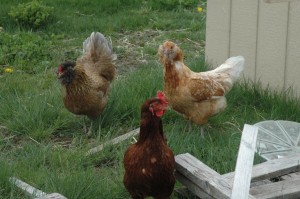
Some times I think that we have some of the most spoiled chickens in the world. They freely roam the entire back yard and garden, except for the pieces of garden I fence them out of. They make messes on the patio and they dig up Tina’s flowers. On the plus side they are excellent pest control. There are no grasshoppers or grubs in my yard. I have only seen one tomato horn worm. We showed it to a chicken and it was gone. I haven’t seen one since. The summer before we got our first chickens, our yard and house were covered with grasshoppers. The grasshoppers were eating everything. They were even eating the salvia. When we got chickens, Tina would take them outside with her as she weeded. They quickly got into the groove of what to eat. Bugs, grubs, worms, ant and grasshoppers had finally met their match. A lightening flash of beak and snicker snack, no more bug.
Another plus is having fresh eggs. My first time of eating fresh eggs from free range chickens was quite different. The yolk was a dark yellow, almost orange color. The surprising thing was that the egg actually had flavor. So this is what an egg is suppose to taste like. I had thought eggs were just a rubbery vehicle for ketchup or salsa.
On a good day we get about 12 eggs. Our little flock has Buff Orpingtons, Rhode Island Reds, a Black Australorp and a few Easter Egg chickens (aka Americana).
The rule from the beginning has been that we don’t name the chickens because they may become dinner some day. For the most part that rule has held. There are two exceptions, Blackie and Big Red. Blackie is the lone Black Autralorp. She survived harvest day 2006 by being faster and more cautious than all of the other chickens. Big Red is just that. The biggest and baddest of the Rhode Island Reds.
I think that I will always keep chickens. A flock of four hens would work in anybodys backyard. Learn to raise your own chickens at BackYardChickens.com
Dirk
